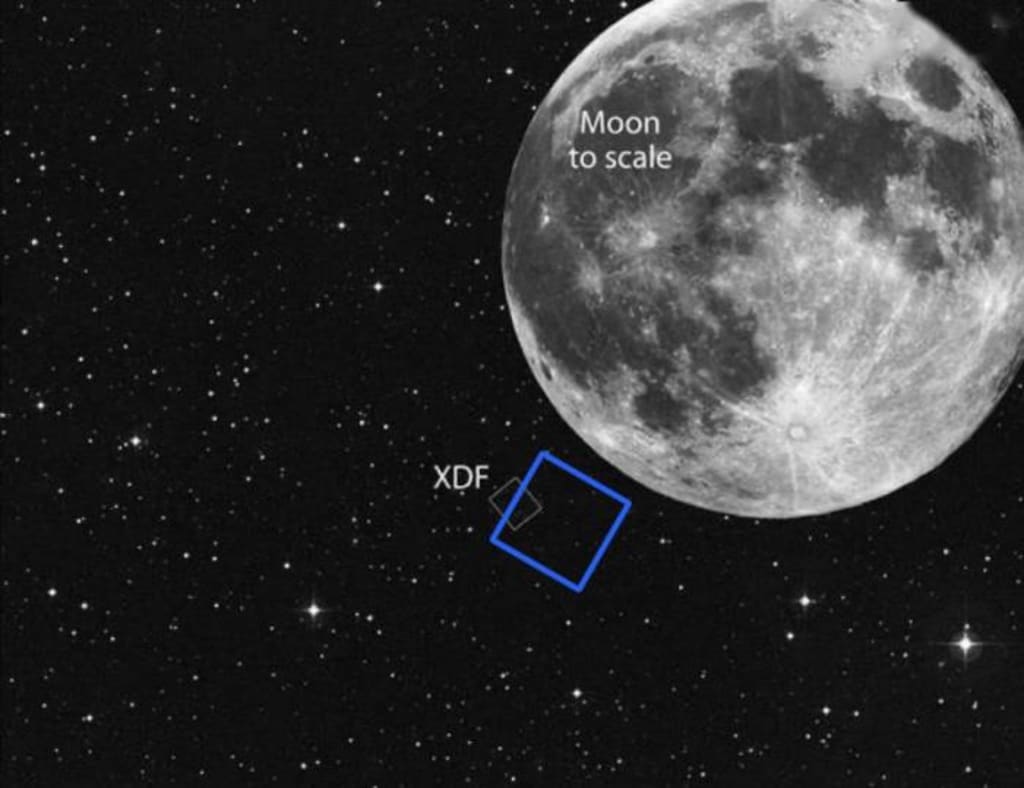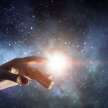In this blue area, seemingly empty, contains 5500 galaxies
The seemingly empty blue area contains 5,500 galaxies

The stars and the sea are deep and charming. It is not easy to really understand it. The distance between them and us humans is too far, and it is easy to cause our visual errors. If you don’t believe it, you can look at this photo and pay attention. Look closely, what do you see? You must have thought that you saw the stars in the sky, and even the not-so-big moon. In addition to this, there is only endless darkness and void. However, next, when we slowly enlarge this photo, you will witness the birth of a miracle. Now we have enlarged this image by a certain number of times, what you see now The moon has become extremely clear, and the lunar sea and radiation patterns are clearly visible.
However, when we look closely, there is a lot of mesh in this image. Now please turn your attention to that blue grid, where the miracle we are about to witness is there, this blue grid and the moon. When viewed from our Earth, this grid is about 1% of the area the moon occupies at a full moon. That is to say, when we look at it with the naked eye on our earth, we cannot see the existence of any matter. There is only a completely dark area. Yet when we continue to zoom in incrementally, what do we see?
We saw a picture of a scintillating mass of galaxies, and within this small swath of our seemingly inky blackness lies a vast map of cosmic stars. There are at least 5,000 galaxies in this photo, each of which is a huge structure comparable to our Milky Way, and these galaxies that we can only see by zooming in and observing only exist in the one we saw at the beginning within the small blue area.
All we see on Earth with the naked eye is a dark black spot, not even a mass. And this photo is the amazing photo released by NASA-Hubble Extreme Deep Field. On September 25, 2012, NASA published a Hubble image of the deep universe on its official website, the full name is "Hubble Extreme Deep Field of View". Abbreviated as XDF, also known as "Hubble Extreme Deep Field". When it comes to this Hubble Extreme Deep Field, we must mention a great telescope, the Hubble Telescope. Before the launch of the Hubble Telescope, humans had no particularly efficient means of observing the universe, and most of them only used astronomical telescopes to observe and speculate on the deep space regions of the universe.
Because of the rotation of the earth, this makes it impossible for us to take a long exposure of a certain region of the universe on the earth, which is bound to prevent us from seeing the light emitted by celestial objects in some distant regions. As a result, astronomers have seen only a limited number of galaxies up to 7 billion light-years away, half the age of the universe. Telescopes on Earth cannot observe how galaxy clusters formed and evolved in the early universe. It wasn't until 1990 that the launch of the Hubble Telescope changed the way humans observe the universe. The advent of the Hubble Telescope has also brought a whole new universe to mankind.
Because the Hubble telescope is hundreds of kilometers above the earth, it is not affected by the rotation of the earth, and it is not affected by the disturbance of the earth's atmosphere at high altitudes. This allows us to use the Hubble telescope to focus on a certain region in the universe for a long time for a long exposure, and in this way we will obtain an unprecedented picture of the universe, which is the origin of the Hubble Extreme Deep Field. The Hubble Extreme Deep Field was born out of the Hubble Super Deep Field, which is different from the previous centralized shooting of the deep field and the ultra-deep field captured by Hubble. The Hubble Extreme Deep Field is formed by superimposing ten years of observational data. The observed sky area is still the Hubble Ultra Deep Field region located in the constellation Fornax, but the area is smaller than that of the Hubble Ultra Deep Field.
To take this image, scientists had Hubble re-point the camera to a small part of the night sky to the south for 50 consecutive days, with a total exposure time of 2 million seconds. In addition to capturing more than 2,000 images with Hubble's two main cameras, the Advanced Sky Survey Camera and the third-generation wide-field camera, scientists also fused some data from the latest infrared cameras to form this famous image. The XDF field of view is the Hubble Extreme Deep Field.
There are at least 5,500 galaxy clusters in the Hubble Extremely Deep Field. Most of the galaxy clusters in the Hubble Extremely Deep Field are very small. They are in a young age of growth and often undergo intense collisions and mergers. It happens to be an exciting gestation period for galaxy clusters, containing many very gorgeous blue giant stars, limited by the expansion of the universe and the speed of light, so that their light has just reached Earth. So the Hubble Extreme Deep Field is a time tunnel of the distant past. It extends the human vision to 13.2 billion years ago, and the universe was only 13.7 billion years old. In other words, the galaxies in the early universe are preserved in this photo.
We have seen the past of the universe through this picture. This is the charm of the universe. We have been able to travel through time and space to a certain extent, and Hubble has also allowed us to see those distant past scenes. Scientists have seen 1 in this picture. A very young and energetic galaxy cluster, it is only 450 million years away from the singularity of the Big Bang. That is to say, we can see the scene 450 million years after the big bang through this photo. Using these pictures left over from the past, scientists can study the formation process of the early universe and reveal the secret of how the universe was born.
It can be said that the Hubble Extreme Deep Field is an upgraded version of the Hubble Deep Field and the Hubble Ultra Deep Field. It can see farther than the Hubble Deep Field and the Hubble Ultra Deep Field. Today's Hubble Telescope has long since grown old. In the past 30 years, it has brought us countless images of the cosmic starry sky and refreshed our understanding of the entire universe. In the future, a more powerful telescope, the Webb Space Telescope, will be launched. As the successor of Hubble, it will be more powerful than Hubble. Perhaps at that time we will see a more magnificent and vast universe, and a real blueprint of the universe is about to unfold towards us.
About the Creator
dardani lennon
The question mark is the key to any science
Enjoyed the story? Support the Creator.
Subscribe for free to receive all their stories in your feed. You could also pledge your support or give them a one-off tip, letting them know you appreciate their work.






Comments
There are no comments for this story
Be the first to respond and start the conversation.